Share this article
Learn from the brightest minds how to predictably and efficiently grow revenue.
Related Content
How to Analyze your Sales Pipeline – Measuring Your Pipeline Health
The key to understanding how your pipeline is performing is knowing what state it is in. The gauge of that is pipeline health. In the first of our series, we looked at creating the foundations of your pipeline and the metrics that are needed to know what is happening within it. In this article, we…
What is Revenue Operations?
They say all roads lead to Rome. If you imagine Rome as revenue, then the role of revenue operations is to make sure that those roads are built in the most efficient way and that they are effectively signposted. Revenue operations, or “rev ops” in it’s shortened form, is the strategic alignment of sales, marketing,…
How Set Up Historical Trend Reporting in Salesforce
A Guide to Set Up Trend Reporting in Salesforce Reporting in Salesforce is one of the most powerful features you have when trying to demonstrate the value of a business. Building key reports in a matter of minutes with a simple drag and drop interface that anyone can use is extremely effective. Being such a…
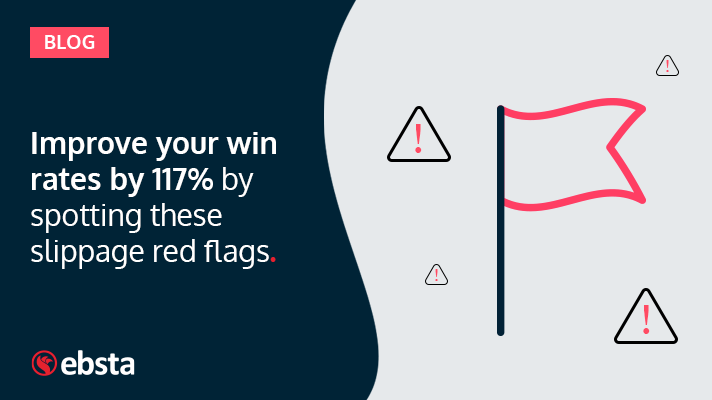
Improve your win rates by 117% by spotting these slippage red flags
The start of the quarter means only one thing – QBR time!
This is a time to understand what worked well and what did not in the previous quarter.
Typically, there is a strong focus on saving the opportunities that have slipped to have the strongest start to the current quarter.
Slipped (as known by Salesforce users) or pushed opportunities (as known by HubSpot users) are active opportunities that are pushed to the next or even subsequent quarters.
Methodology
We analyzed $100bn of open pipeline to reveal the key factors why opportunities slip from the last quarter to the current.
Why?
So you can easily identify the telltale signs of risk that an opportunity is going to slip. Equipped with this knowledge, sales teams can then be proactive to salvage these opportunities, close them faster and improve win rates.
Let’s get into the data
All opportunities were categorized into pipeline (early in stage), best-case (mid-stage) or commit (late in stage) opportunities.
Commit slippage
Opportunities in commit are the most critical.
This is because these are the opportunities that have been validated by sales managers.
A good sales process says if you are in the last month of a quarter, opportunities should not slip without the go-ahead from a manager.
This is reflected in the data.
As opportunities slip further, win rates drop.
For example, win rates drop by half when an opportunity is pushed from 1 week to 1 month for commit opportunities.
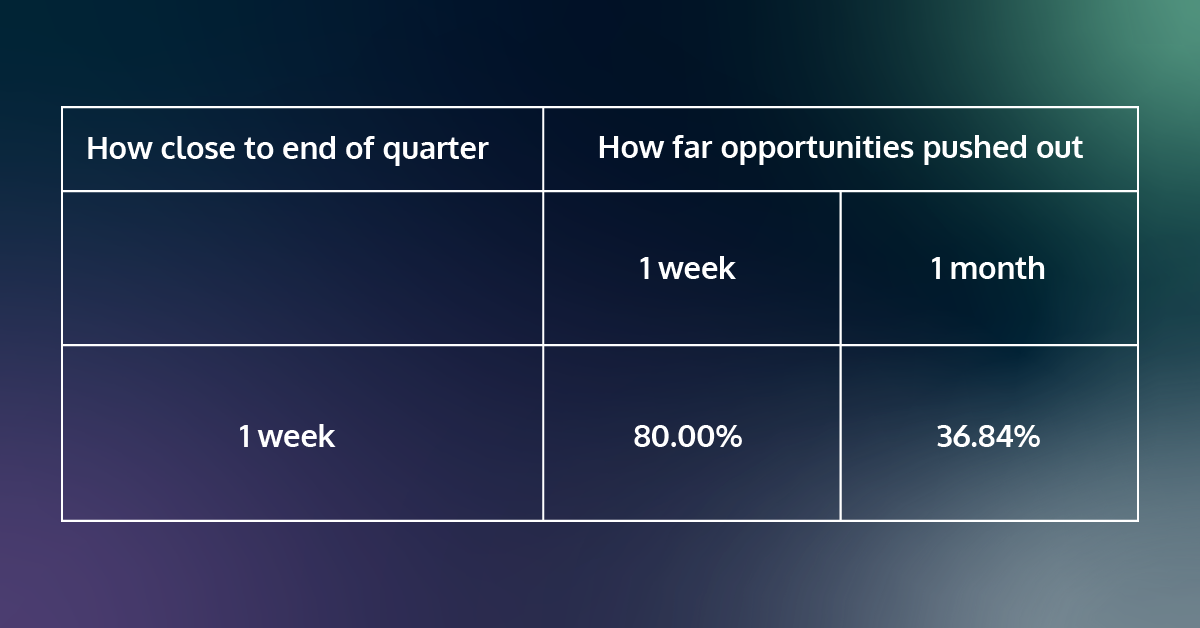
You might be thinking well a win rate of 36% is not actually that bad.
But if you consider that this is a deal that is in commit stage – a win rate of only 36% is a major red flag.
Now, the story changes when an opportunity is pushed out a considerable amount.
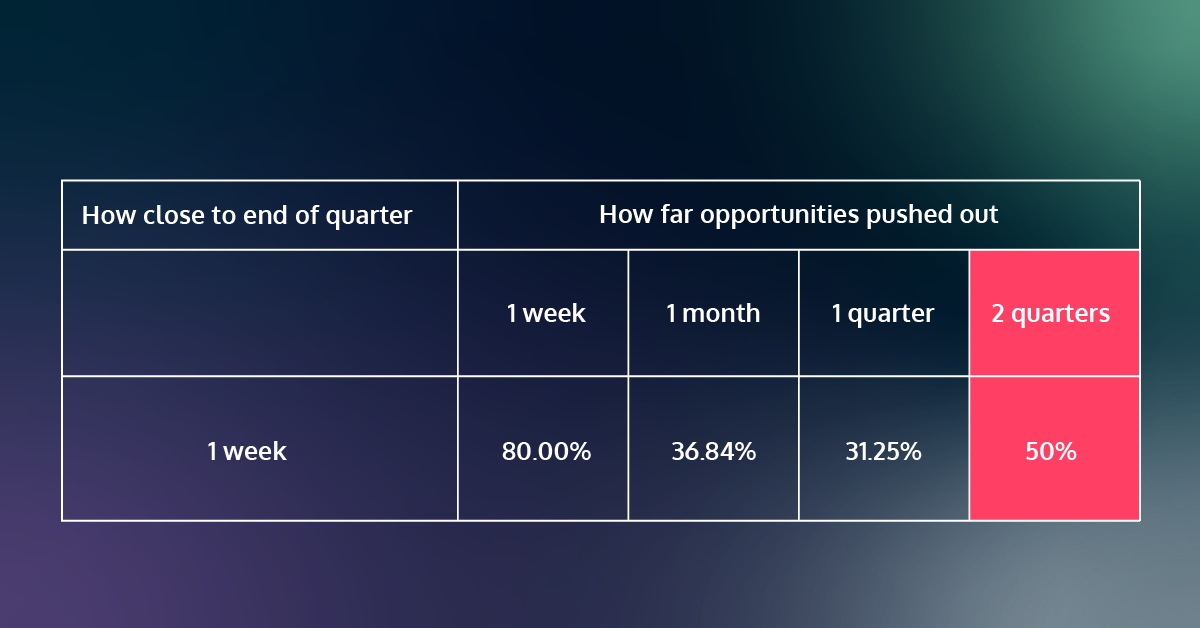
When an opportunity is pushed out by 2 quarters, the win rate begins to creep back up. Why?
Salespeople typically align close dates to their fiscal quarters.
This is bad practice.
Part of the discovery process should be to understand when budgets become available, allowing you to align close dates with the prospects’ fiscal quarters, rather than your own.
This allows you to set a more accurate close date from the get-go and allocate your sales reps’ time better.
Pipeline slippage
There is a correlation between the opportunity stage and the amount of times an opportunity is pushed out.
Pipeline opportunities typically slip late (61%) in the quarter as illustrated by the data below:
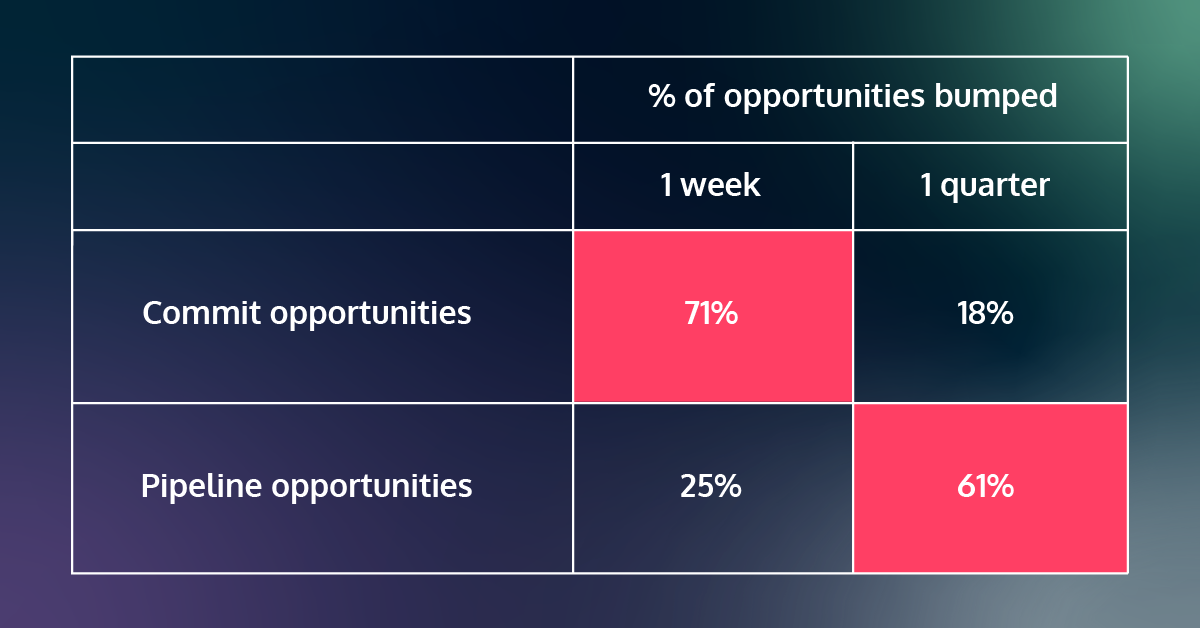
Compared to commit opportunities which slip more earlier on (71%).
This is just good discovery.
Opportunity close dates are expected to shift as discovery progresses. As you align budgets, manage optimism or pessimism, understand the prospects’ requirements better, or hold ups in legal or other teams – these are all part of good discovery.
Cutting your pipeline losses
If an opportunity in your pipeline slips by more than a couple of months, then this is a prospect who still needs to be nurtured and it could be argued that this opportunity should be closed-lost.
Why?
Salespeople can hold onto opportunities in the hopes of them closing – but hope is not a strategy.
Not closing opportunities results in your sales cycle growing and renders your data useless.
You are left with skewed pipeline data.
This can have negative effects on your opportunities hygiene and this is the perfect time to implement the process.
In fact, we found that companies who update their CRM regularly have 23% higher win rates.
How to avoid slippage
It all comes down to a good process.
Good process gives you full visibility of your pipeline to ensure there are no opportunity hygiene issues.
An example of a good process is a forecasting cadence.
A forecast cadence is a standardized series of meetings that can drive your sales teams to deliver on their targets and achieve the organization’s goals.
It provides a simple and consistent pipeline review and forecasting process which allows you to identify issues, such as slippage, as they arise and combat them head-on.
Consistency is the key to growth and to achieve consistency you need:
- A single source of truth
- A well-implemented forecast cadence
Factors affecting slippage
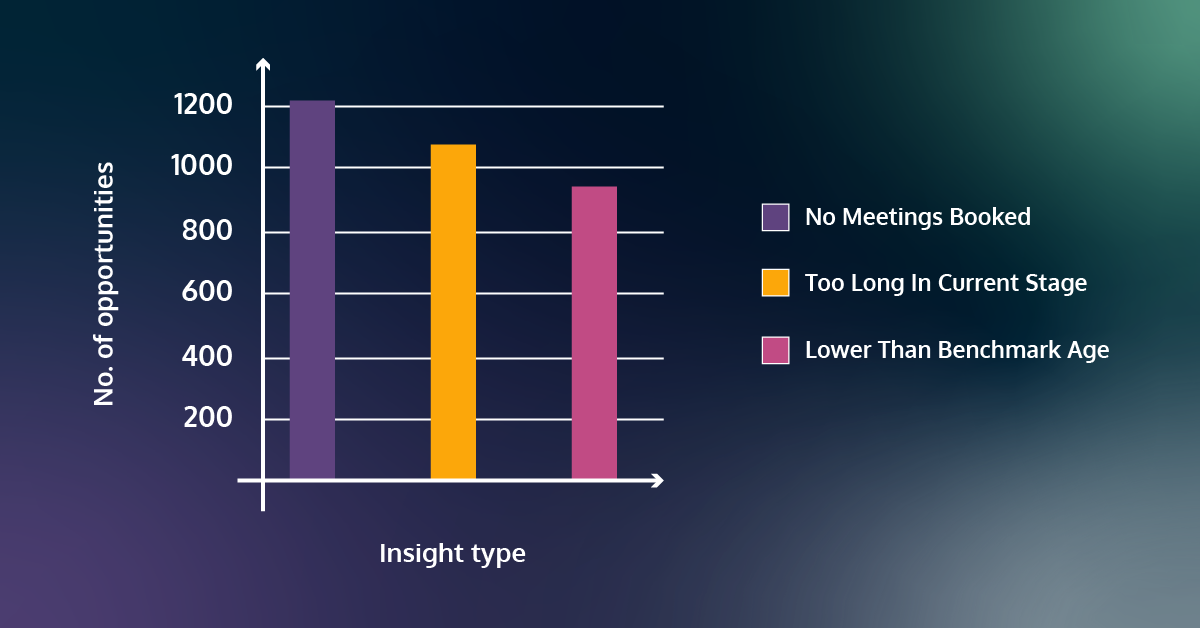
- No meetings booked
This is a fairly obvious one. If engagement from an opportunity is waning, the further back it will get pushed.
- Too long in current stage
Now this is a tricky one:
– How do you know when an opportunity is in a stage too long?
– Do you have the visibility to spot this?
Ebsta’s Revenue Intelligence platform allows you to spot opportunities at risk in real-time by highlighting positive and negative factors affecting your opportunities.
You can deep dive into every opportunity.
For example, if a deal was in a stage longer than your average benchmark, this would pop up as a negative factor when you investigate that opportunity.
With Ebsta you can see activity, understand how they are performing, compare performance to your historical benchmarks and take action to steer them in the right direction.
- Relationships
If you have a refined sales process, one of the first questions a manager would ask in a pipeline review is ‘why is this opportunity stalling?’
Followed by:
- How do we escalate this?
- How do we get the right person engaged?
- Take a look at the sentiment behind the most recent communication
Understanding who your relationships are with and the strength of these relationships can help you to avoid slippage altogether.
Key takeaways
- How far an opportunity slips and when it slips has a dramatic effect on win rates
- As soon as the opportunity slips a considerable period of time, your priority should be understanding why this has happened.
- If it is due to any other reason than misaligning fiscal quarters, then it is a risk factor.
- The most common risk factors affecting slippage are no meetings booked, too long in current stage, and relationships.
- Slipped opportunities prevent sales teams from closing more deals every single quarter, and should be a key priority for leaders to resolve.
- Ready to stop opportunities slipping to the next quarter? Get started with a forecast cadence today.


